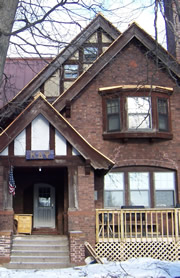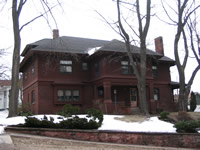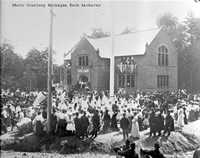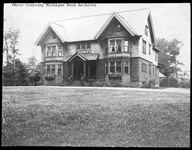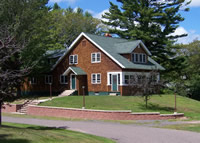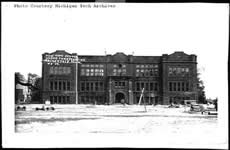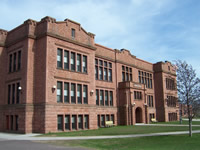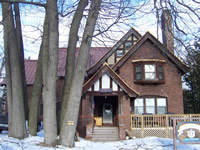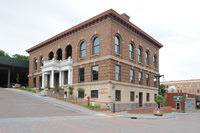Close House The Close House was built for James Jr. and Katherine Close on Center Street in East Hancock. James was a bookkeeper at First National Bank of Hancock in late 1880s. He was also a part owner of a warehouse called Close and Hodgson which sold building materials as well as wholesale coal and flour.4 The house has a broad hipped roof with deep eaves, giving it a Prairie-style effect. The basement is stone, the first story brick, and the second story clad in shingles. A two-story projection on the front is open on the first floor, creating a porch, but enclosed on the second and topped with a hipped roof. There is leaded glass in the upper portion of most windows.5
Sarah Sargent Paine Memorial Library The Sarah Sargent Paine Memorial Library, dedicated to the mother of William Paine, the president of Copper Range Consolidated Company, was many things for the community, accommodating meetings, classes, theater shows and church services. The 86’ x 37’-6” building was constructed in 1902-1903 and served the Painesdale community until it was condemned in 1962 due to an unstable foundation. The basement had a kitchen, dining room, club rooms, and public baths. Bookshelves on the main floor contained many volumes in the immigrant miners’ native languages. The main floor also had a children’s room with curved windows, window seats, children’s books and a large fireplace, as well as smoking and card rooms and an adult reading room with a large oil painting of Mrs. Paine over the fireplace. The second floor had an auditorium used for community functions. The building was demolished in 1965.7 The Jacobean Revival building had a prominent cross gable with a Tudor-arched entrance.8 Above the entrance were three windows topped with an elaborate hoodmold. Flanking the center bay, each of the side bays had a bay window with a balcony. The entrance was framed by smooth stone which contrasted with the rough-cut Jacobsville sandstone of the rest of the building. A smooth beltcourse ran around the building, dividing the first and second floors. Hubbard House One of most elaborate houses in Painesdale was built in 1903 for Dr. Lucius L. Hubbard, the general manager of the Champion Mining Company, who lived here for only about two years. A subsequent general manager, William Schacht, occupied the house for many years. The rectangular building has a symmetrical front façade, a blend of Classical Revival, Shingle, and Queen Anne Revival styles.9 The building is two-and-a-half stories tall and sits on a raised red sandstone foundation. The entrance is flanked by two-story bay windows sheltered by exaggerated cross gables, supported by large brackets.10 The front entrance faces away from the street and looks out over the mine shafts. The original design had clapboard siding on the first floor and shingles on the second story; it has since been resided.11 A two-story carriage house and stable with a vented gable roof is of wood-frame construction, with clapboard siding on the first floor and shingles on the second floor.
H. S. Goodell House This one-and-a-half-story wood-shingled bungalow stands next to the Hubbard House among management housing in Painesdale. H. Stuart Goodell ran the South Range Mercantile Company and was apparently not an employee of the mining company. He was married to Charlotte, Lucius Hubbard’s daughter. The broad side-gable roof extended to cover a porch across the front and had a large gable dormer. The center-hall plan had a living room on one side and a dining room and kitchen on the other.12 The house soon received a one-and-a-half story addition with shed-roofed dormers.13 In 1910 Goodell lived here with his wife, two young daughters, two servants, and a nurse.14
Champion Copper Company Doctor’s House This Colonial Revival house has a five-bay front with two-story fluted pilasters at the corners. The 44’-10” x 32’ building is two stories with a side-gable roof. A one-story, three-bay porch centered on the front has recently been reconstructed. The wood-frame house was sided with clapboards. The center door entered into a wide center hall, with a living room and dining room to the left and a library and kitchen on the right. The second floor had five bedrooms and a bathroom. The servants’ stairway led to their bedroom in the attic and their bathroom in the basement.15 Painesdale High School (Jeffers High School) This Jacobean Revival building was constructed of rough-cut Jacobsville sandstone. The 140’-long building has a flat roof with shaped parapets on each end of the building. It has a symmetrical façade with five main windows, except the center portion, which has three. The central arched entrance bay projects from the building. There are smooth stone lintels over the grouped windows and a smooth stone beltcourse marking the line between the first and second stories. The entrance also has pilasters that have small buttresses on them that frame the Tudor-arched entrance. The interior is appointed with granite, marble, and tile. Originally, the gymnasium, locker rooms, kitchen, and dining room were in the basement; the chemistry and physics lab, a sewing room, and recitation rooms were on the first floor; and a sky-lit assembly hall on the third floor.16 The building was heated with steam from the mine. In 1913 electric lights were installed in the building. In 1928-1929 a tunnel connected this building to the Sarah Sargent Paine Memorial Library, which originally stood near the high school.
Hubbard House Lucius L. Hubbard had been the state geologist before he was hired to manage Champion Mine in 1899. Hubbard was forced out by 1905, though, and moved to Houghton, from where he presided over the Ojibway Mining Company in Keweenaw County. By 1910 he was living in this house designed for him by Eschweiler.17 The two-story house faced with dark-brown bricks has a cross-gable roof with nested gables in the front. Portions of these gables are half-timbered. The second-floor front façade has an oriel window. The entrance is recessed. At the eaves rafter and purlin ends are carved.
Houghton Club (U.P. Engineers and Architects Corporate Headquarters) Eschweiler produced drawings for the Houghton Club, formed by businessmen in the Houghton area, in 1906. As originally designed, it had a third story which accommodated a ballroom.18 Apparently the Club had difficulty raising the funds for this, because construction was not begun until 1910, and the building was reduced in size to two stories and a basement. Even so, it cost $55,000 to build. The Houghton Club was built in the Classical Revival Style, and the exterior is symmetrical with seven bays across the front. The facade has three distinct horizontal divisions between the three floors of the building. The basement, which is fully exposed on the northern side of the building due to the slope of the land, is of a rusticated stone that differentiates it from the brick second and third floors. Above this is the first or main floor with rectangular windows that have three horizontal panes. Above the windows there are splayed lintels with light-colored keystones that stand out against the darker brick. Above these windows is a contrasting stone beltcourse that divides the main and top floors. The second-floor windows are all arched; the two on each end are grouped together and the three in the middle are set back inside an arcaded porch. The roof is flat with a modillioned cornice. The main floor of the club had a parlor, “grille room,” and billiard room, while the second floor had private dining rooms, bedrooms, card rooms, and library. The basement had the kitchen and servants’ area, as well as a gymnasium and locker room. When the building opened on December 15, 1910, the Daily Mining Gazette reported,
The Houghton Club occupied the building until 1933 when it was bought by the village of Houghton for municipal offices for only $1,835.19 The city renovated the inside, moving rooms around and adding new windows on the back of the building. In 1991 U.P. Engineers and Architects, Inc., bought the building and renovated the interior to closely match the original interior of the building.20
|
